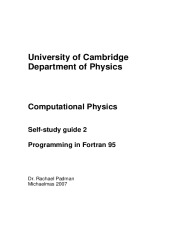Programming in Fortran 95
Download Fortran 95 course, PDF tutorial for beginners to learn the basics of Fortran programming language.
Table of contents
- A very simple program
- Running the program
- Variables and expressions
- Other variable types: integer, complex and character
- Intrinsic functions
- Logical controls
- Advanced use of if and logical comparisons
- Repeating ourselves with loops: do
- The stop statement
- Expressions and the assignment statement
- Control instructions
- The tables
- Reading and writing operations
- The procedures
- Modules
- Structures or derived types
- The DFLIB graphic library
- Procedures: Advanced concepts
- Modules: Advanced concepts
- Pointers
- Optimization notions
- Execution in command lines
- Array arithmetic
- GOOD PROGRAMMING STYLE
- Readability
- Self-checking code
- Write clear code that relates to the physics
- INPUT TO AND OUTPUT FROM A F95 PROGRAM
- F95 statements for I/O
- GRAPHICS AND VISUALISATION
- Plotting a data file
- Getting help
- Further examples
- Printing graphs into PostScript files
- Functions
- Formal definition
- Subroutines
- Local and global variables
- Passing arrays to subroutines and functions
- Size and shape of array known
- Arrays of unknown shape and size
- The intent and save attributes
- USING MODULES
- Modules
- public and private attributes
- NUMERICAL PRECISION AND MORE ABOUT VARIABLES
- Entering numerical values
- Numerical Accuracy
Introduction to Fortran
Machine code (numeric notation in octal);
- mnemonic code assemblers;
- 1954: project creation of the first language symbolic FORTRAN by John Backus from IBM (Mathematical FORmula
TRANslating System):
- Efficiency of generated code (performance);
- Quasi natural language for scientists (productivity, maintenance, readability).
- 1957: Delivery of the first compilers;
- 1958: Fortran II (IBM) ⇒ independently computable sub programs.
- Generalization to other manufacturers but:
- Divergence of extensions ⇒Normalization requirement;
- ASA American Standards Association (ANSI).
Committee for the development of a FORTRAN standard. 1966: Fortran IV (Fortran 66);
- Evolution by divergent extensions. . .
- 1977: Fortran V (Fortran 77).
almost compatible:
no iteration of the null loops (OD I = 1.0)
- Main news:
- type character;
- IF-THEN-ELSE;
- Direct access I / O and OPEN.
Anne Fouilloux Patrick Corde (anne.fouilloux@ecmwf.int Patrick.Corde@idris.fr Language Fortran (Base)) January 29, 2018 8/265
Introduction History
- Work of the X3J3 / ANSI and WG5 / ISO committees to modernize Fortran 77:
- Standardization: inclusion of extensions;
- Development: new concepts already exploited by newer languages APL,
Algol, PASCAL, Ada; . . .
- Performances in scientific computing;
- Fully compatible with Fortran 77.
- 1991/1992: Fortran 90 standard (ISO and ANSI);
- 1994: Fortran 90 Cray and IBM first compilers;
- 1997: Fortran 95 standard (ISO and ANSI);
- 1999: First compilers Fortran 95 on Cray T3E then IBM RS / 6000;
- September 2004: Fortran Standard 2003 (ISO and ANSI);
- October 2010: Fortran Standard 2008 (ISO and ANSI).
| Size : | 326.145 Kb |
| File type : | |
| Downloads: | 414 |
| Created: | 2018-05-21 |
Warning: Trying to access array offset on false in /home/tutovnfz/public_html/article.php on line 233
Others Fortran Tutorials
Introduction to programming with Fortran 95
Others related eBooks about Programming in Fortran 95
A Byte of PythonPython is one of those rare languages which can claim to be both simple and powerful. You ..., download free Python tutorial in PDF (117 pages) created by Swaroop C H ....
How To Code in GoThis book is designed to introduce you to writing programs with the Go programming languag..., download free Go tutorial in PDF (447 pages) created by Cory LaNou ....
The Coder's ApprenticeThe Coder's Apprentice is a course book, written by Pieter Spronck, that is aimed at teach..., download free Coding tutorial in PDF (398 pages) created by Pieter Spronck ....
IOS tutorial for developersDownload free PDF tutorial about IOS programming, learn how to creat your IOS applications, this document is a complet training course in 893 pages....
Algorithms and Data Structures With Applications to Graphics and GeometryAn introductory coverage of algorithms and data structures with application to graphics and geometry. ...
Getting started with HibernateDownload free Hibernate tutorial course in PDF, training file in 14 chapters and 39 pages. Free unaffiliated ebook created from Stack OverFlow contributor....
2D Game Development: From Zero to HeroDownload free course 2D Game Development: From Zero to Hero, pdf file on 262 pages by Self-publishing....
Essential AlgorithmsThis book written to provide clear and concise explanation of topics for programmers both starting to learn the Algorithms as well as those diving in more complex topics. Most examples are linked to online playground that allows you to change the code and re-run it....
Professor Frisby's Mostly Adequate Guide to Functional ProgrammingThis is a book on the functional paradigm in general. We'll use the world's most popular f..., download free Functional Programming tutorial in PDF (146 pages) created by Brian Lonsdorf ....
Pointers - C++ coursePDF course about C++ and pointers, free document in 65 pages....
